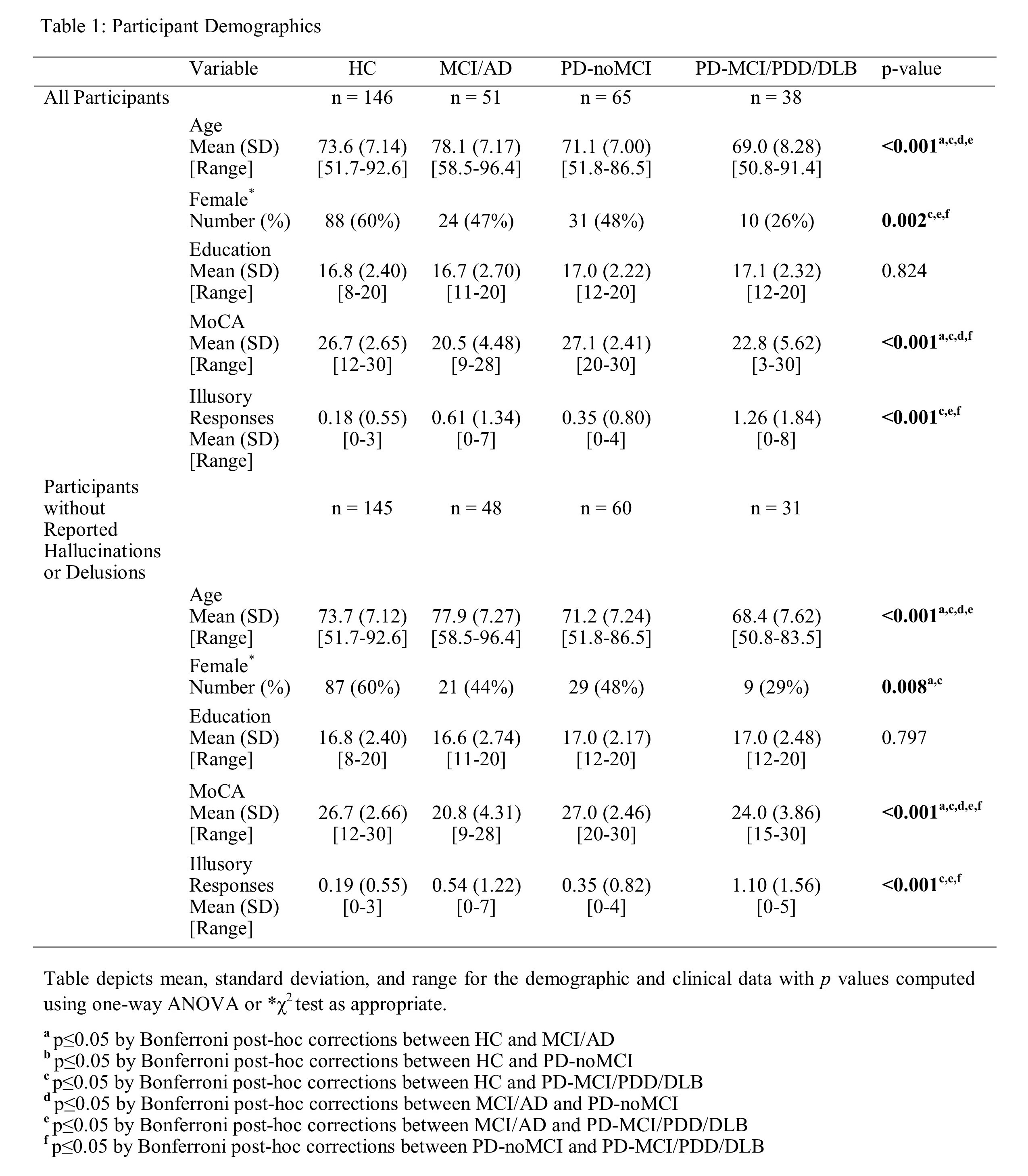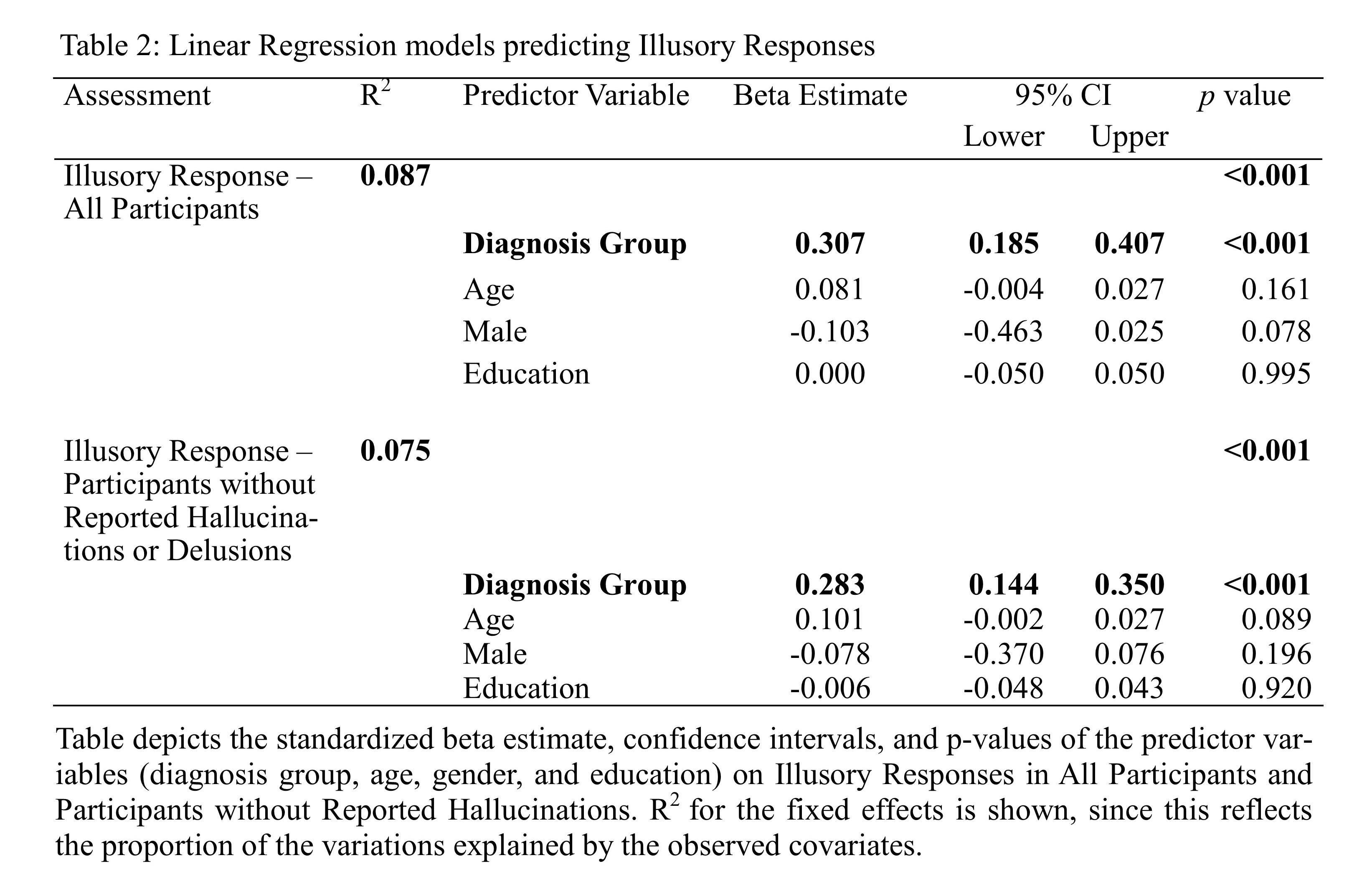Objective: To determine whether non-hallucinating Lewy body disease-spectrum patients report increased illusory responses.
Background: Pareidolias are specific illusions of faces and objects perceived in formless visual stimuli[1]. Studies using a noise pareidolia task have shown that dementia with Lewy bodies (DLB) patients report more illusory responses than Alzheimer’s disease patients, which correlates with severity of visual hallucinations[2]. However, it is unknown whether illusory responses occur in earlier stages of disease or in non-hallucinating patients across the Lewy body disease-spectrum, including PD without cognitive impairment (PD-noMCI) or PD with mild cognitive impairment (PD-MCI) and dementia (PDD).
Method: We studied the NACC Noise Pareidolia Task (Lewy body disease Module[3]) in 300 participants from the Stanford ADRC and Pacific Udall Center after comprehensive motor and cognitive assessments with consensus diagnostic adjudication. The four diagnosis groups included 65 PD-noMCI, 38 Lewy body disease with cognitive impairment (PD-MCI/PDD/DLB), 51 Alzheimer’s disease-spectrum (MCI/AD), and 146 HC. We performed an ANOVA to determine the between group differences in illusory responses and a linear regression to determine whether diagnosis group, age, gender, or education predict illusory responses. We repeated analyses after removing participants with patient/caregiver reported hallucinations or delusions (MDS-UPDRS 1.2 and NPI).
Results: We found significantly more illusory responses in PD-MCI/PDD/DLB group compared to the PD-noMCI, MCI/AD, and HC groups [table 1]. In the regression analysis, diagnosis group was significantly associated with more illusory responses (β[CI]; 0.307 [0.185-0.407]); by contrast, age, gender, and education were not associated with illusory responses [table 2]. After removing participants with reported hallucinations or delusions, we still found more illusory responses in the PD-MCI/PDD/DLB group compared to PD-noMCI, MCI/AD, and HC and in the regression analysis diagnosis group solely remained a significant predictor of illusory responses (0.283 [0.144-0.350]).
Conclusion: Across the Lewy body disease-spectrum, we found increased illusory responses in non-hallucinating patients with cognitive impairment compared to patients without cognitive impairment. Longitudinal studies are needed to determine whether increased illusory responses predict future hallucinations.
References: [1] The psychosis spectrum in Parkinson disease. Ffytche D, Creese B, Politis M, Chaudhuri K, Weintraub D, Ballard C, Aarsland D. Nat Rev Neurol. 2017 Feb; 13(2): 81–95. [2] Hallucinators find meaning in noises: pareidolic illusions in dementia with Lewy bodies. Yokoi K, Nishio Y, Uchiyama M, Shimomura T, Iizuka O, Mori E. Neuropsychologica. 2014 Apr; 56: 245-54. [3] https://www.alz.washington.edu/WEB/forms_lbd.html
To cite this abstract in AMA style:
M. Shahid, A. Rawls, V. Ramirez, S. Ryman, V. Santini, L. Yang, S. Sha, J. Hall, T. Montine, L. Tian, B. Cholerton, V. Henderson, M. Yutsis, K. Poston. Increased illusory responses in non-hallucinating, cognitively impaired Lewy body disease patients [abstract]. Mov Disord. 2020; 35 (suppl 1). https://www.mdsabstracts.org/abstract/increased-illusory-responses-in-non-hallucinating-cognitively-impaired-lewy-body-disease-patients/. Accessed December 7, 2025.« Back to MDS Virtual Congress 2020
MDS Abstracts - https://www.mdsabstracts.org/abstract/increased-illusory-responses-in-non-hallucinating-cognitively-impaired-lewy-body-disease-patients/


